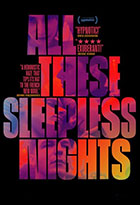
All These Sleepless Nights (Wszystkie nieprzespane noce) 2016, US 2017
Distributed by Passion River Films, 154 Mt. Bethel Rd., Warren, NJ 07059; 732-321-0711
Directed by Michal Marczak
DVD , color, 1h 40min.
General Adult
Experimental Film, Urban Areas, Interpersonal Relations, Sexual Behavior, Warsaw, Eastern Europe, Youth, Social Behavior
Date Entered: 04/06/2018
Reviewed by Dmitrii Sidorov, California State University, Long BeachAfter Michal Marczak won the directing prize in the World Cinema Documentary competition at the prestigious Sundance film festival, this film received considerable attention and praise (e.g., “movie that Terrence Malick has been trying to make”, IndieWire) even if its “fittingly surreal nocturnal vibe” (The Los Angeles Times) may have resulted in “favoring lyricism above substance“ (The New York Times). The film is indeed in many respects unconventional yet should be noticed and appreciated by teachers of courses on urban sociology, Eastern Europe, youth cultures and sociology.
This coming-of-age documentary-fiction hybrid docudrama in scenes both staged and scripted focuses on Kris (Krzysztof Baginski) and his contemporary Polish twentysomething friends and ex-lovers who play themselves and take the viewer with them through nostalgic EDM soundscapes of Warsaw.
The film’s focus on nocturnal hours (as highlighted in its title) is natural: not only are these universally the hours of young people, but also regionally the summer time (with its drastically reduced nights) has a much higher significance in northern Eastern Europe compared to, say, California, and is indeed fully celebrated by young Poles and their neighbors (St. Petersburg has the White Nights Festival in June). The social dimension of Europe’s seasonality (and specifically of its valuable summer) as captured in this film provides useful visualization for area studies courses.
The focus on night hours also allows the filmmaker to cleverly utilize the advantages of a new portable prosumer level camera (Sony a7s) with its outstanding low light capabilities. This is arguably a disruptive development for filmmaking: the camera (Sony a7s) has revolutionized the process that is now increasingly within the reach of novice film artists. The filmmaker had to create his own gimbal stabilizer though; most of the film is made “on the go”, without the steady tripods or other conventional film gear that unavoidably would establish a distance from its elusive youthful subjects. Instead, the non-intrusive portable DIY gimbal allowed close following of its heroes in their difficult to access places such as open-air parties, alleys, apartments and clubs, conveying both an artistic sense of ephemerality and sociological honesty. This is arguably where the future of cinema is—small mobile teams with portable cameras, open to improvisation, avoiding cinematic conventions and better equipped to break new ground. This is nevertheless a staged “reality.” For example, all dialog is re-recorded in a looping (or ADR) process later and that provides ground for in-class discussion of the blurred boundaries between documentary and fiction. For the innovative technical aspects of this film project, see the NoFilmSchool interview.
Urban geographers and urbanists will be thrilled to see this film that makes a previously cinematically unexplored major contemporary city, Warsaw, one of its main characters. Although the film has been criticized for lacking a clear direction and moving in circles (such “eventlessness” may be seen as an intentional metaphor for the young, post-Communist, Eastern Europe in search of itself), it nevertheless does have some subtle structure moving from an opening “underground” meeting place of the two friends with complicated relations with their ex-lovers to Kris’ more solitary contemplations from a high-rise studio with a more elevated view of the downtown and the communist Palace of Culture. One of the film’s last bittersweet scenes is solitary Kris sitting in a park dressed as a pink bunny and awkwardly communicating with adults via sound amplifier, perhaps an allusion to the part-time position of a promoter for consumer goods that many East Europeans without solid education eventually have to accept as an entry-level job and a step to social maturity. An analysis of the order of urban scenes in the film may be an exciting course project. (Locations are listed at the Internet Movie Database web site.)
The soundscape of the film deserves special praise. The nostalgically ambient EDM music is indeed popular in Eastern Europe, that will allow for a fruitful discussion with students of its similarities with and differences from the famous LA-based La La Land musical film (2016). Despite their locational, historical, and social differences, youth in both cities face similar challenges explained through music, dance and choreographed movements in an urban space. All These Sleepless Nights is a remarkable achievement, a worthy contribution to an emergent film genre of urban youth wanderings (see also Walking the Streets of Moscow (1964), The Stroll (2003) at the crossroads of the sexual, the social, the urban and the geopolitical.
Awards:
- Sundance Film Festival, 2016, Directing Award/World Cinema – Documentary